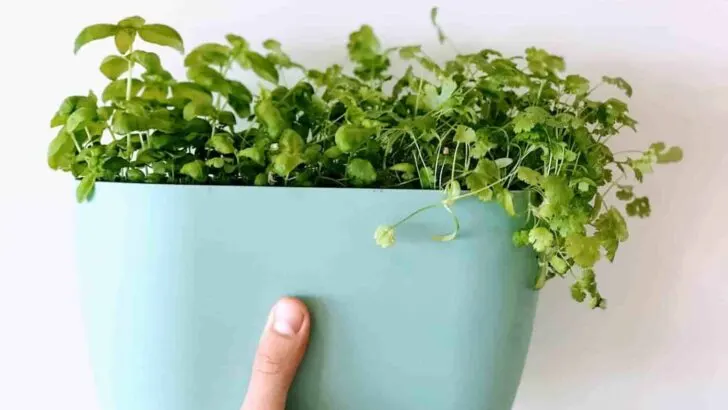You may ask yourself: “How to keep herbs alive indoors?“.
Growing herbs in your garden and on your balcony are well known.
However, you can also grow herbs indoors.
Keeping herbs alive indoors has many benefits as you can control the environment better in terms of temperature, humidity and water.
On the other hand, you need to setup and maintain the right conditions for your herbs.
Who doesn’t love a nice mint tea in summer, pasta with basil pesto with the family or some nice Asian dishes spiced up with cilantro?
The same goes for oregano and parsley.
In this article, I am going to provide you with my best tips on how to care for herbs indoors.
According to the University of Maryland, herbs offer a lot of health benefits.
How to Keep Herbs Alive Indoors
To keep herbs alive indoors make sure to remove and replace the soil the herbs come with, thin out the stems in the pot and remove the dead leaves. Water herbs every 1-3 days depending on your indoor conditions when the soil is almost dry. Use a potting mix containing sand, perlite and peat for your herbs. A pot with drainage holes is best. Use an organic fertilizer at half-strength for herbs.
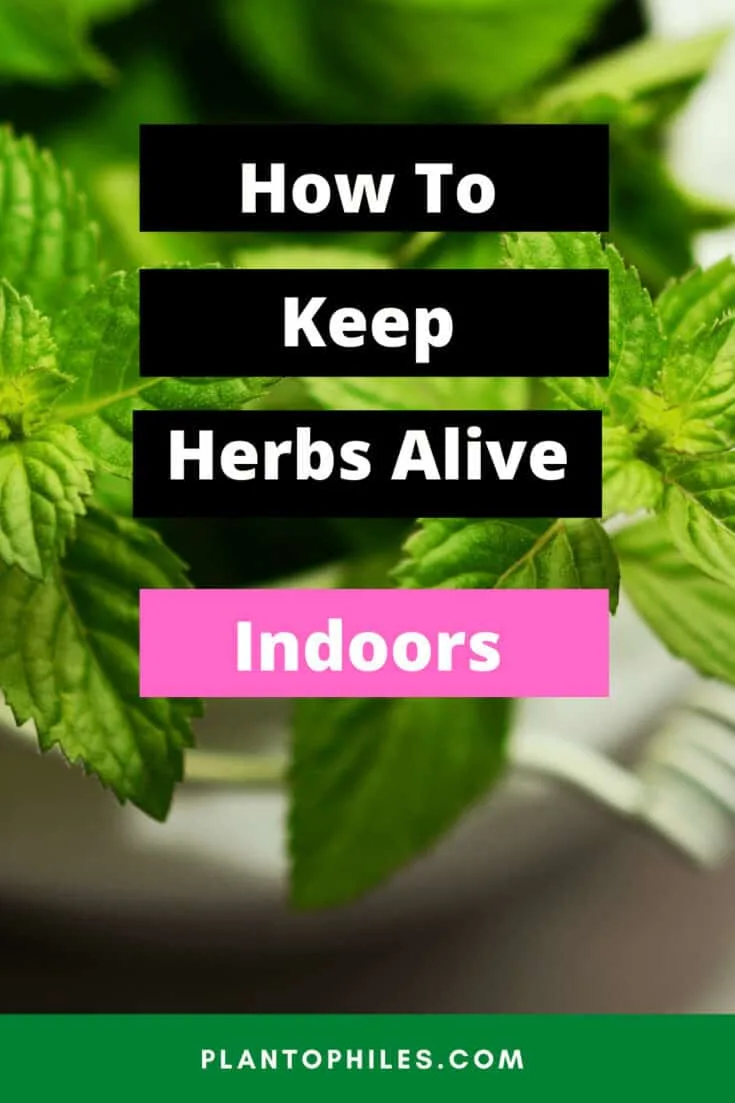
How to keep herbs alive indoors
Table of Contents
How To Keep Herbs Alive Indoors
Soil for Herbs Indoors
To grow herbs idoors use potting soil from a gardening store. Avoid native soil as it often contains diseases and pathogens from outside. It is also to dense for potted herbs indoors.
Soil for potted plants will allow for sufficient airflow and thus oxygene to the roots and will be less dense.
Light for Herbs Indoors
Herbs indoors need lots of light. Most herbs need high light intensity ranging from 6’000 – 10’000 foot candles (FC).
Therefore make sure to place herbs indoors directly in front of the brightest window in your house or apartment but not too close to avoid extreme temperatures.
Watering for Herbs
Most Herbs need a lot of water and watering herbs indoors requires you to water herbs every few days at least. As a general rule of thumb water herbs at least every 3-4 days.
Make sure the potting soil of herbs does not get completely dry and water whenever the top 2-3 inches of soil are almost dry.
Herbs prefer to be slighty humid. However avoid soggy soil as this will lead to root rot.
Watering herbs indoors can be a challenge speaking based on personal experience.
I suggest using some kind of semy-hydroponic system or even full hydroponics to grow herbs succesfully.
Temperature for Herbs Indoors
Average indoor temperatures between 68° to 76°F (20-24 °C) are sufficient for herbs indoors.
Avoid cold drafts as well as extreme heat from herbs being too close from windows, doors or heaters and air conditioning.
Herbs are adaptable in terms of temperature and by avoiding extreme temperatures, the indoor temperatures will be just fine.
Humidity for Herbs Indoors
Herbs need at least 50% humidity to grow well. This can become a problem when growing herbs indoors in winter because of heaters (radiators, air vents etc.) according to Missouri Botanical Gardens.
The result will be wilting plants as well as crispy leaves.
To avoid these conditions and to increase the humidity for herbs use a pepple tray filled with water underneath pots and also put plants closely together.
Avoid to put herbs indoors right next to a window (but put it close) and avoid heaters and close by air conditioners.
Fertilizer for Herbs Indoors
Fertilizing herbs indoors is important as the fertilizer supply in potted soil is limited and herbs need fertilizer to grow new leaves and grow taller.
You can either use slow-release fertilizer or liquid fertilizer. I suggest using 1/2 to 1/3 of the recommended fertilizer strenght as herbs are often fragile and fertilizer does concentrate in pots.
The best way to fertilize herbs indoors is to fertilize lightly but more often.
Growth for Herbs Indoors
Growing herbs indoors can mean that herbs grow slower han outdoors. The brightest window indoors will max out at 5’000 FC (foot candles) and maybe 6-8 hours of light.
Most herbs need 8-12 hours of bright sunlight and between 6’00-10’000 FC for optimal growth.
A good solution is to provide additional aritifical light using a grow light.
Potting for Herbs Indoors
When potting herbs indoors make sure to use a pot with drainage holes in the bottom. This way root rot is less likely to occur.
In addition, airflow can better get to the roots.
I suggest using plastic or ceramic pots for herbs indoors as terracotta pots might dry out the soil too quickly.
The best pots for herbs indoors are semi-hydro pot systems using a water reservoir and a wick system.
You can also go full hydroponics to max out the growth potential of herbs indoors.
Pruning for Herbs Indoors
Pruning herbs indoors spring and summer is best as this is the main growin phase for herbs.
Avoid pruning herbs indoors in winter as much as possible as any new growth in winter is more likely weaker and flimsier than growth in spring and summer.
Propagation for Herbs Indoors
Herbs are easily propagated indoors.
Here is how to propagate herbs indoors:
- Make sure to cut off a stem section with several nodes and leaves
- Use a clean pruning shear, knive or scissors and disinfect the blades
- Remove the bottom leaves and put the herb into a container with fresh water
- Put the container into a bright spot (eg. a windowsill)
- Change the water every few days
- Wait 3-4 weeks until new roots are stating to form
- Once roots are several inches long remove the herbs from the water
- Put the new plant into its own potting soil and choose an appropriate pot size
How to keep basil alive indoors
Who doesn’t love basil? It is one of the most versatile and most used herbs in kitchens all around the world.
You may think that basil is impossible to grow indoors as I did for most of my adult life.
This is mainly because basil is often bought in supermarkets.
This basil is produced to be sold and eaten fast.
It has travelled and was often kept and transported in cold temperatures in order to look fresh for the end client.
The basil you buy in plastic pots is mostly crowded, and the single plants have to fight for light.
Further, it often comes with little soil and has dying leaves on the soil ground.
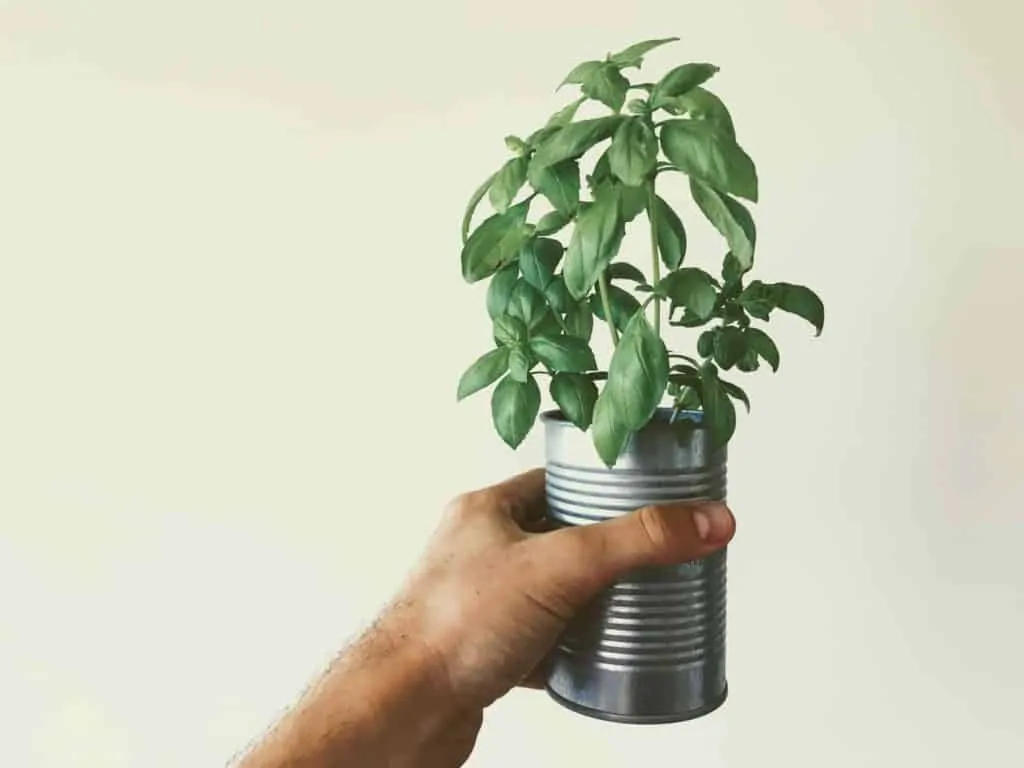
How to keep basil alive
Well well, these are for sure not the best circumstances for your indoor basil cultivation.
These basil plants may die within days as most of mine did in the past.
But you do not have to worry.
Even such basil can be used to grow an almost indefinite amount of basil and these plants might live for not only days but years to come.
In the next section, we will show you how you grow basil as part of our how to keep herbs alive indoors article.
How to keep supermarket-bought basil alive step by step guide
These are the step by step instructions to buy supermarket basil and keep it alive:
Step 1: Go to the supermarket and buy a basil plant in soil.
Step 2: Once you are home, remove the dead leaves and plant residues from the soil as these might rot and produce fungus and thus harm the basil plant.
Step 3: Remove the soil from the container as it is often of low quality. Exchange it with your own high quality indoor/outdoor plant soil.
Step 4: Thin out the individual plants/stems. They are often very crowded so that you have enough plants for two pots or one larger pot.
Great. The first important steps are done to keep your basil alive.
In the next section, we will tell you how to care for your basil plants as part of the herbs to grow roundup.
Provide sufficient lighting for your indoor basil
Indoor care for Basil plants is easy if you follow some general rules regarding light and watering.
Let’s start with the light. Basil plants love light and the heat that comes with it. The more the better in terms of light in general.
Therefore place your basil in a south or west-facing window if possible.
But from your experience also an eastern window with a couple of hours of morning light will do.
Read our light and window direction article for further guidance.
If you do not have the opportunity to provide such a spot, there are a lot of growing lights available that will keep your basil plants happy.
Watering your Basil indoors
So we provided enough light.
The next thing that we need to get right is the watering.
Watering is such an important part of keeping herbs alive.
If you want a general rule of thumb, water your basil every 1-3 days.
But better than a rule of thumb is to actually take that thumb and put it a few inches into the soil. If it is still wet (soil sticks to your thumb), do not water your basil.
Once the soil feels dry, water your basil plants. It is actually that easy. We water our basil on average every two days, each day might be too frequent in most cases.
Please also make sure that that the water drains well and no water remains in the saucer underneath the pot.
That’s it, basil care indoors is easy if you follow a few general guidelines.
Have fun with your indoor basil.
Use it for soups, make pesto or salads!
Plucking leaves on indoor basil
Let’s shed some light on how to pluck leaves on basil indoors so your basil plants stay alive and happy.
The experts are divided whether you should pluck your leaves from the top or bottom of the plant.
I see a tendency towards picking the top leaves in the community against the general tendency to pick the bottom leaves.
In my experience, picking the biggest leaves usually works great for us although the smaller the leaf the better the taste.
It is important that you pick leaves every couple of days so your plants stay happy.
Also, remove damaged leaves or leaves that don’t look extremely healthy.
The damaged leaves are still good to eat.
Also, never remove all the leaves on a stem as you will give your basil plant a hard time to continue its growth.
Health benefits of basil
Basil does not only taste good it is also super healthy.
It contains antioxidants and is supposed to help fight cancer. It has antibacterial properties and is anti-inflammatory.
But not enough, it is also a great source of vitamins as it contains: vitamin C, magnesium, calcium, potassium, and iron.
It may even help you to manage stress. Here is an overview of all it’s health benefits:
Health Benefits of Basil Summarized
- Basil is antibacterial
- anti-inflammatory
- Source of many vitamins such as vitamin C, magnesium, calcium, potassium, and iron
- Helps to manage stress
- Fever-reduction
- Pain-reduction
- Blood vessel protection
- Helps to fight cancer
Having learnt how to care for basil and gotten to know about its health benefits, let’s now move on to Peppermint as part of the herbs to grow guide.
How to keep peppermint alive indoors
I love a good mint or peppermint tea!
The peppermint plant is fairly easy to grow indoors. Its care is very similar to the basil plant.
You will need well-draining soil and a pot with great drainage is optimal as you will not overwater the plant.
Use a good potting mix containing sand, perlite and peat and you are ready to grow yourself some tasty mint.
Read our guide on well-draining soil for more guidance.
The main difference between the basil pant is that the mint plant likes to be moist at all times.
With moist we do not mean that the mint plant is soaked in water but rather that it stays a little moist to the touch and you shouldn’t let it dry out too much.
You can also mist mint plants, something a basil plant wouldn’t appreciate.
Put the mint plant in front of an east-facing window in summer and a west-facing window in winter to ensure enough sunlight for your mint.
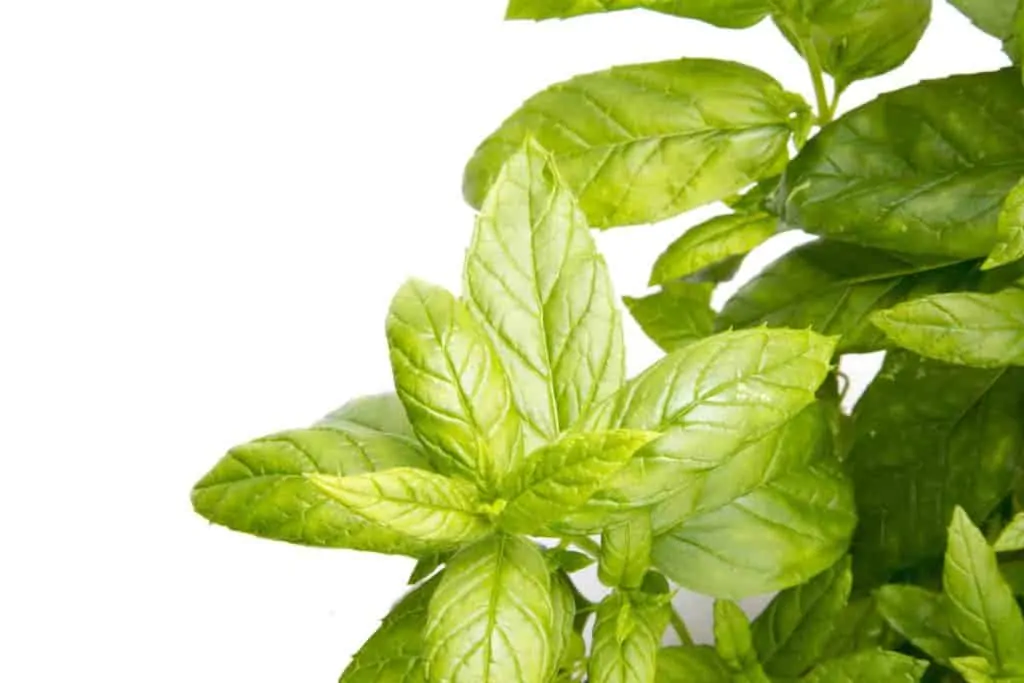
Indoor Peppermint care is not only possible but enables you to have peppermint available whenever you fancy a tea
Like most herbs, you can grow your mint plant also directly in water.
Fill a glass, a vase or a jar with water and put your cuttings of the peppermint plant in it.
Make sure that no leaves touch the water by plucking the bottom leaves.
Health Benefits of Mint
Mint is your go-to breath refresher.
No wonder it flavours chewing gums and toothpaste alike.
But it is also great against a cold and sore throat as it contains menthol. Peppermint water is even supposed to improve breastfeeding as peppermint water can heal nipple injuries caused by infants.
To summarize this section we wanted to give you a full health benefits overview for mint:
Health Benefits summarized:
- Breath refresher
- Helps against the cold and sore throat as it contains menthol
- Peppermint water helps with breast-feeding
- Great for your digestion
After learning about the mint plant, let’s explore the exotic tasting cilantro plan.
How to keep cilantro alive indoors
Cilantro is next on our herbs to grow list.
Cilantro is the leaf part of the coriander plant.
Its taste is very unique and only a little is sufficient to give a dish a very distinctive flavour.
It tastes better fresh than dried and it is, therefore, a great herb to grow indoors so you can always pluck some fresh leaves when you need them.
One thing to know is that the coriander plant doesn’t like to be transplanted.
I recommend growing this plant from seeds as it is more fragile than other herbs.
It is also quite hungry for nutrients so please have a fertilizer ready.
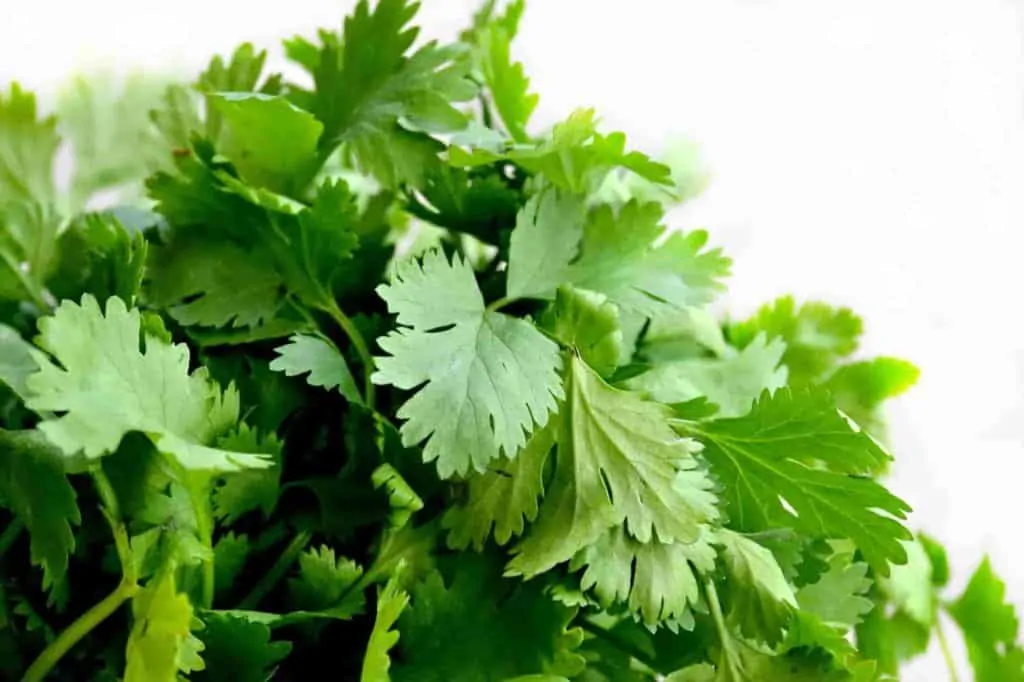
How to care for cilantro indoors
Important: Use organic fertilizer for herbs and plants you are planning to eat.
Regular fertilizer is not beneficial for your health at all.
Also do not use the full strength of the fertilizer. Dilute it and use half-strength at best as you do not want to burn the root system.
Otherwise, you might have to say bye-bye to your cilantro-amigo.
Health benefits of cilantro
Cilantro is rich in Vitamins. It contains Vitamin K, A, C and E and is rich in Folate, Zinc, Calcium, Iron, Magnesium and Potassium.
Also, Cilantro treats fungal and bacterial infections, helps digestion and is good against food poisoning.
And the cilantro plant is able to lower blood sugar and kill parasites in the body.
Health Benefits summarized
- Rich in vitamins K, A, C and E
- Contains Folate, Zinc, Calcium, Iron, Magnesium and Potassium
- Helps to trea fungal and bacterial infections
- Helps digestion
- Good against food poisoning
- Lower blood sugar
- Kills parasites in the digestive tract
Whilst Cilantro is often used in the Asian kitchen, the Oregano plant is a herb often used in Italy and in the Mediterranean kitchen as well as in Mexico.
How to keep oregano alive indoors
This plant loves the heat and is found in Mediterranean and Mexican kitchen. It needs good drainage as this is essential in herbs to grow.
So make sure your soil is well-draining and that you are using a pot that has drainage holes.
Furthermore, a ground containing soil, moss, peat and perlite is best for its well being. Oregano grows best in bright light. 8 hours of light would be optimal.
You get these conditions if you place your oregano plan in a south-facing window.
As the basil the oregano needs to dry out between watering and profits from regular cuts so new growth can develop.
All in all, oregano is an easy herb to grow. Let’s move over to the health benefits of Oregano.
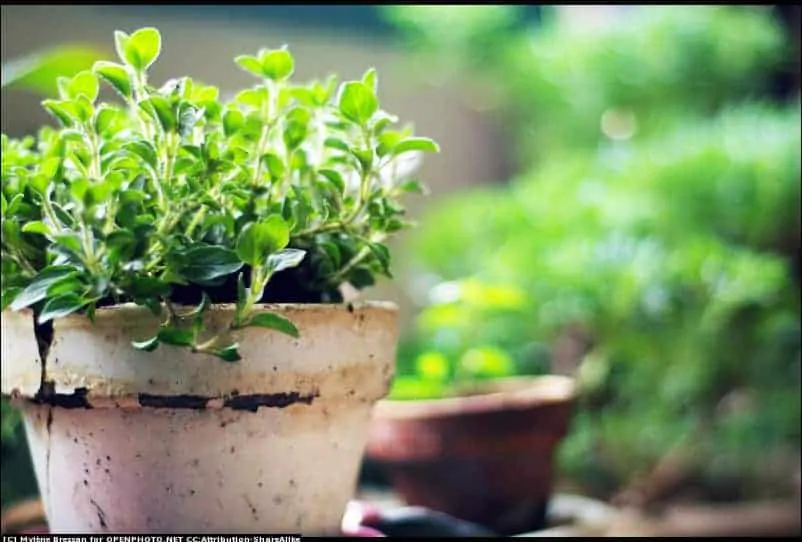
Care for oregano indoors and have the additional benefit of a bug repellent
Health benefits of Oregano
The oregano plant is a perfect bug repellent but you can use it as a medicine as well. The Ancient Greeks knew this long ago.
Besides that, it can help against cancer, osteoporosis and diabetes and many more illnesses such as headaches, muscle pain and are well known for its anti-inflammatory benefits.
Health benefits summarized:
- Protection against cancer, osteoporosis and diabetes
- Good against acne and dandruff
- Anti-inflammatory
- Good against muscle pain
- Headaches
- Toothache
- Menstrual cramps
- Fatigue
Now let’s have a look at the indoor care of the herb chive.
How to keep chives alive indoors
It is great to have chives indoors as it is a great herb to spice your dishes. It is often used to top baked potatoes. Keep it in a window with 6 to 8 hours of sunlight.
You can achieve this by placing this herb in a south-facing window.
Make sure to rotate it frequently so the chives do not grow too much to one side.
The plant also profits from a frequent trim that fosters new growth and prevents blooming.
Once chives bloom the leaves will whiter and turn brown.
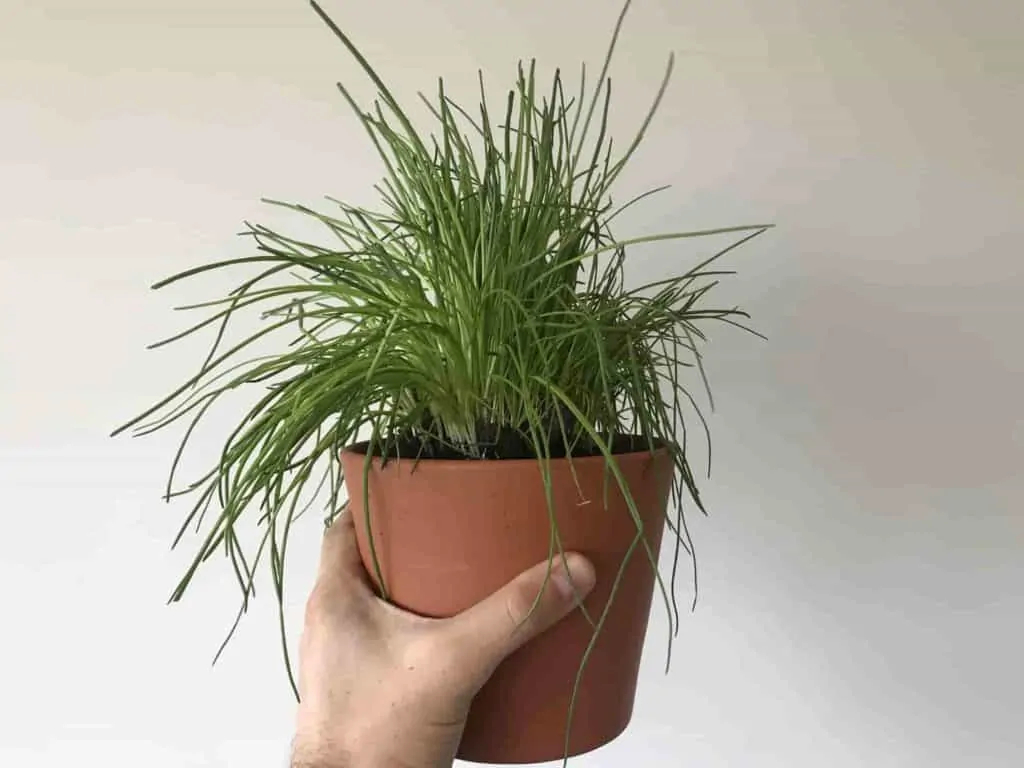
How to grow chives indoors. To be honest, I personally find this one rather difficult to grow.
When growing chives indoors don’t forget to keep the humidity. You can do this by either place it on a bowl with stones and water or by spraying the chives from time to time with water.
Water your chives once the topsoil of your container or pot is dry.
As with all indoor herbs, a well-draining pot or container filled with again well-draining soil is necessary.
Health benefits of chives
Chives have several benefits and were brought to America mainly due to their health benefits.
It is mineral and vitamin-rich and helps to prevent certain types of cancer. It contains vitamin K and is therefore good for bone strength.
100 grams of chives will provide you with roughly 145% of the recommended daily dose of Vitamin A.
This demonstrates what powerhouse chives are when it comes to nutritional value.
Only two tablespoons of chopped chives will give you the necessary daily dose of vitamin K.
Chives is very nutrient-rich and therefore essential for a healthy diet. In the following, we have summarized the main health benefits of this herb for you.
Health benefits summarized
- Chives contain vitamins A and C as well as vitamin KIs mineral-rich and contains calcium, magnesium and potassium
- Has antioxidants
- Is preventing the effects of stomach and colorectal cancer
- Helps sleep due to choline
Let’s move over to our bonus paragraph explaining how you can get an endless supply of herbs for your indoor herb garden as this is really the main benefit of herbs to grow, indoors and outdoors.
How to propagate herbs indoors
How do you propagate herbs so you have an almost indefinite supply of them?
The most important thing is where you cut your herbs. Y
our cuttings should have an optimal length of around 4 inches.
It is important that you take clean scissors or a knife.
You can even disinfect them as you want to avoid hurting the plant where you make the cut from.
If the blades are dirty you may infect the mother plant and it might even die.

Cutting from herbs needs to be done right
Well, let’s go back to where to do the cut.
Cut herbs such as basil right below a leaf node.
Remove the lower leaves so if you put the cuttings into the water there won’t be any leaves that might rot.
Wait until the roots are 2 inches or longer and then you will be ready to plant your herbs into the soil.
It is important to know that you can repeat this step again and again.
You can cut the cuttings once they are big enough and therefore multiply your supply of basil, oregano, peppermint or whichever herb you want to get more from.
How To Keep Herbs Alive Indoors in Winter
To keep herbs alive indoors in winter make sure that the herbs get sufficient bright direct to indirect light from an eastern, southern or western-facing window.
You can also use artificial lighting in form of grow lights to meet the lighting needs of herbs in winter. Stop pruning herbs 8 weeks before the first frost as new growth in winter will be more fragile.
Avoid a placement directly at the window as this spot might be much colder and also you expose your herbs to cold drafts.
Place herbs in winter as close to a window as possible while avoiding the extreme temperatures.
Do Herbs Need Direct Sunlight Indoors? Many Do Any Light Levels At Home Are Often Insufficient
Choose the sunniest spot in your home as most herbs prefer bright direct to direct sunlight. Ensure that herbs are close to a window as light falls off quickly the farther you move away from a window.
Avoid the extreme temperatures of plants being too close to a window as window spots get very hot and can be drafty and cold in winter.
According to the University of Wyoming, light might be 100 FC (foot candles) directly in front of a window but fall off to just 3 FC 3 feet away.
Herbs need at least 6 hours of sunlight per day to thrive. A sign of insufficient sunlight is leggy growth.
Basil, as well as Rosermary, prefer full sunlight (bright direct). 6-8 hours of full sunlight is optimal.
Basil needs 6’000-10’000 FC and 12 hours of light per day for optimal conditions.
10’000 FC equals to full sun in summer.
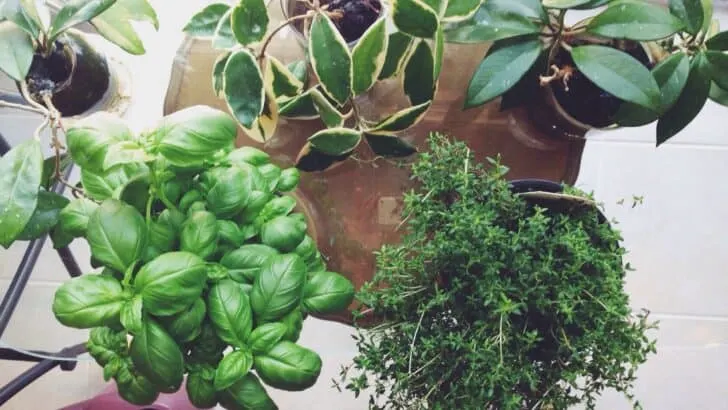
Do Herbs Need Direct Sunlight Indoors? Herbs such as Basil and Rosemary do as well as other herbs
Herbs that can be grown indoors
There are many herbs that can be grown indoors such as:
- Basil
- Cilantro
- Thyme
- Chives
- Rosemary
- Lavender
- Dill
- Parsley
- Sparemint
- Sage
- Marjoram
Conclusion To How to Keep Herbs Alive Indoors
To keep herbs alive indoors make sure that you are changing the soil with store-bought herbs come with. Water the herbs every 3-4 days once the soil is dry and ensure that the herbs get bright indirect to direct light. Use a pot with drainage so excess water can drain.
Ultimately If you get a few things right such as the needed amount of light, water and soil and if you put your herbs in the right container/pot, you will have a sheer unlimited supply of herbs at your fingertips.
You can buy your herbs at the supermarket, either as whole plants or cuttings. When you buy herbs at your garden centre you will often get higher quality plants.
You can also raise your herbs from seeds as this is fairly easy as well.

Daniel has been a plant enthusiast for over 20 years. He owns hundreds of houseplants and prepares for the chili growing seasons yearly with great anticipation. His favorite plants are plant species in the Araceae family, such as Monstera, Philodendron, and Anthurium. He also loves gardening and is growing hot peppers, tomatoes, and many more vegetables.

